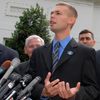If there's one point of agreement between President Obama's supporters and his critics, it's that Barack Obama bears little resemblance to Ronald Reagan. However, on one major issue, this point deserves a rethink. President Obama's vision of a world free of nuclear weapons is straight out of Ronald Reagan's playbook. The "New START" nuclear weapons treaty that President Obama signed shows his resolve to keep America secure, just as the elder Republican did.
It's easy to forget, but Ronald Reagan believed that nuclear weapons deserved to be abolished as soon as reasonably possible. To his mind, such weapons were "totally irrational, totally inhumane, good for nothing but killing, possibly destructive of life on earth and civilization." That's why he launched negotiations with the Soviet Union, reducing the likelihood of nuclear conflict and working toward the day when the world's deadliest weapons could become a relic of the past.
Of course, President Reagan realized that a nuclear free world was nowhere near the horizon. Instead of pie-in-the-sky delusions, his administration created a long-term framework for reducing the risk of nuclear war. A major piece of that framework was the Strategic Arms Reduction Treaty, known as START. The final treaty was signed by President George H.W. Bush and went into force under President Bill Clinton. At its birth, START helped ease Cold War tensions. When it expired in 2009, the U.S. and Russia had cut their nuclear arsenals by eighty percent.
Barack Obama has looked to replicate Ronald Reagan's vision of a nuclear free world, and his practical success in turning that vision into a reality. In April 2009, President Obama gave a major speech in Prague, promising American leadership in working toward a world free from nuclear weapons. His first order of business: concluding a "New START" treaty with Russia to achieve further reductions in unnecessary nuclear weapons.
The U.S. and Russia possessed enough nuclear weapons to destroy the planet several times over. To minimize the risk of nuclear war -- accidental or intentional -- the two nations would work together to reduce excess weapons. Each country would keep enough to satisfy basic security needs, while getting rid of unnecessary firepower.
This is the same motivation that animated President Reagan in the 1980s. But President Obama has more threats to address. Terrorists are seeking nuclear weapons, dangerous nations such as Iran are running nuclear programs, and countries that do not possess nuclear weapons are looking to develop nuclear energy programs that could easily be turned into weapons programs.
Since the United States and Russia possess 95% of the world's nuclear weapons, President Obama knew other nations would refuse to limit their own nuclear ambitions if the world's top two nuclear powers didn't take the first step. Furthermore, the new treaty reduces the likelihood of accidental nuclear war, while shrinking the amount of nuclear material in the world, making it more difficult for terrorists to acquire nuclear weapons.
When Barack Obama and his Russian counterpart sign "New START" this week, they will take a major step in making the world a safer place. While we face new threats abroad and polarized politics at home, the sight of a Democratic President carrying on the tradition of a Republican predecessor does more than protect US security. It goes a long way in proving that morning in America is far from over.
